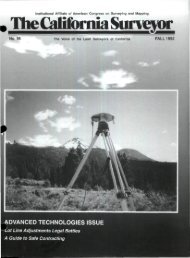Institutional Afftliatie of Kmerican 6ongress on Surveying and ... - CLSA
Institutional Afftliatie of Kmerican 6ongress on Surveying and ... - CLSA
Institutional Afftliatie of Kmerican 6ongress on Surveying and ... - CLSA
You also want an ePaper? Increase the reach of your titles
YUMPU automatically turns print PDFs into web optimized ePapers that Google loves.
Articles (c<strong>on</strong>tinued)<br />
DEVELOPING EFFICIENT<br />
SURVEY TECHNIQUES<br />
James K. Crossfield, Ph.D.<br />
Associate Pr<str<strong>on</strong>g>of</str<strong>on</strong>g>essor, Dept. <str<strong>on</strong>g>of</str<strong>on</strong>g> Civil<br />
<strong>and</strong> <strong>Surveying</strong> Engineering,<br />
California State University, Fresno,<br />
Fresno, CA 93740<br />
Abstract<br />
Recent advances in applicati<strong>on</strong>s<br />
<str<strong>on</strong>g>of</str<strong>on</strong>g> c<strong>on</strong>venti<strong>on</strong>al surveying equipment<br />
are keeping this technology<br />
competitive with high technology<br />
systems. The Global Positi<strong>on</strong>ing<br />
System promises to revoluti<strong>on</strong>ize<br />
surveying activity, while a terrestrial-based<br />
field positi<strong>on</strong>ing unit<br />
needs further development. The real<br />
property comp<strong>on</strong>ent <str<strong>on</strong>g>of</str<strong>on</strong>g> any developing<br />
l<strong>and</strong> informati<strong>on</strong> system must<br />
be properly merged in a positi<strong>on</strong>al<br />
<strong>and</strong> legal sense with other types <str<strong>on</strong>g>of</str<strong>on</strong>g><br />
data. Systems analysis techniques<br />
that c<strong>on</strong>sider the cost factor must<br />
be available to those who must<br />
design, c<strong>on</strong>struct <strong>and</strong> maintain<br />
multipurpose l<strong>and</strong> records informati<strong>on</strong><br />
systems.<br />
Introducti<strong>on</strong><br />
The analysis <str<strong>on</strong>g>of</str<strong>on</strong>g> efficient survey<br />
techniques requires more than just<br />
a perfunctory look at currently<br />
available theodolites, distance<br />
meters <strong>and</strong> total stati<strong>on</strong>s. Predicti<strong>on</strong>s<br />
about the tremendous promise<br />
<str<strong>on</strong>g>of</str<strong>on</strong>g> satellite-related Global Positi<strong>on</strong>ing<br />
System (GPS) receivers or realtime<br />
coordinate readout devices are<br />
expected, but efficient surveying<br />
equipment al<strong>on</strong>e cannot enhance<br />
multipurpose l<strong>and</strong> informati<strong>on</strong> systems<br />
unless the proper envir<strong>on</strong>ment<br />
exists. This envir<strong>on</strong>ment or organizati<strong>on</strong>al<br />
c<strong>on</strong>text dem<strong>and</strong>s that the<br />
primary fruits <str<strong>on</strong>g>of</str<strong>on</strong>g> l<strong>and</strong> surveying<br />
(boundary surveys) <strong>and</strong> all appUcable<br />
related title documents have a<br />
meaningful role in the overall<br />
system. Ultimately, selecti<strong>on</strong> <str<strong>on</strong>g>of</str<strong>on</strong>g> a<br />
given survey technique must occur<br />
within the overall c<strong>on</strong>straints that<br />
exist at the particular locati<strong>on</strong> <str<strong>on</strong>g>of</str<strong>on</strong>g> implementati<strong>on</strong>.<br />
This selecti<strong>on</strong> requires<br />
that a delicate balance be<br />
maintained between the minimum<br />
acceptable specificati<strong>on</strong>s required<br />
<strong>and</strong> the maximum allowable funding<br />
available for any specific multipurpose<br />
l<strong>and</strong> informati<strong>on</strong> system<br />
applicati<strong>on</strong>.<br />
C<strong>on</strong>venti<strong>on</strong>al <strong>Surveying</strong> Equipment<br />
The modernizati<strong>on</strong> <strong>and</strong> automati<strong>on</strong><br />
<str<strong>on</strong>g>of</str<strong>on</strong>g> c<strong>on</strong>venti<strong>on</strong>al surveying<br />
equipment are well-documented<br />
facts. C<strong>on</strong>venti<strong>on</strong>al equipment is<br />
taken here to mean those devices<br />
used to measure angles <strong>and</strong> distances,<br />
using electr<strong>on</strong>ic, optical, or<br />
physical means (taping, etc.) C<strong>on</strong>venti<strong>on</strong>al<br />
surveying procedures<br />
have, in a sense, remained virtually<br />
unchanged for centuries. The newer<br />
<strong>and</strong> faster methods for obtaining<br />
<strong>and</strong> processing raw field data<br />
(angles, directi<strong>on</strong>s, <strong>and</strong> distances)<br />
are merely the applicati<strong>on</strong>s <str<strong>on</strong>g>of</str<strong>on</strong>g><br />
modern technology to c<strong>on</strong>venti<strong>on</strong>al<br />
surveying procedures.<br />
Kermeth Gold recently said, "The<br />
total stati<strong>on</strong>s <str<strong>on</strong>g>of</str<strong>on</strong>g> that day (year 2000)<br />
will have small data collectors, <strong>and</strong><br />
the accessories will involve 'briefcase'<br />
computers <strong>and</strong> even plotters<br />
for in-the-field completi<strong>on</strong>s" (Miller,<br />
1985). Gold's predicti<strong>on</strong>s are indeed<br />
astute when taken in Ught <str<strong>on</strong>g>of</str<strong>on</strong>g> a recent<br />
paper given by an <str<strong>on</strong>g>of</str<strong>on</strong>g>ficial <str<strong>on</strong>g>of</str<strong>on</strong>g> a<br />
major surveying equipment manufacturer<br />
(Martin, 1985). Martin evaluated<br />
the time requirements for observing<br />
<strong>and</strong> calculating a particular<br />
comm<strong>on</strong> c<strong>on</strong>venti<strong>on</strong>al surveying activity.<br />
Four different equipment<br />
<strong>and</strong> procedure combinati<strong>on</strong>s were<br />
tested, each involving different<br />
amounts <str<strong>on</strong>g>of</str<strong>on</strong>g> computati<strong>on</strong>al automati<strong>on</strong><br />
<strong>and</strong> equipment sophisticati<strong>on</strong>.<br />
These combinati<strong>on</strong>s represented<br />
c<strong>on</strong>venti<strong>on</strong>al surveying equipment<br />
<strong>and</strong> procedures typically available<br />
<strong>and</strong> used for the years 1975, 1980,<br />
1983, <strong>and</strong> 1985. Martin's time study<br />
revealed that 114, 90, 85. <strong>and</strong> 68<br />
minutes, respectively, were required<br />
to accompUsh the same task in<br />
these different years. Extrapolating<br />
this reducti<strong>on</strong> in time due to<br />
automati<strong>on</strong> to about 1988 would<br />
suggest that an overall productivity<br />
increase <str<strong>on</strong>g>of</str<strong>on</strong>g> 100% should occur in<br />
c<strong>on</strong>venti<strong>on</strong>al surveying equipment<br />
<strong>and</strong> procedures during the 13-year<br />
period from 1975 to 1988.<br />
This trend is significant. It suggests<br />
that c<strong>on</strong>venti<strong>on</strong>al surveying<br />
equipment <strong>and</strong> procedures are<br />
evolving <strong>and</strong>, for many appUcati<strong>on</strong>s,<br />
may c<strong>on</strong>tinue to be competitive<br />
for some time. Thus, cauti<strong>on</strong><br />
is necessary when predicting<br />
the future role <str<strong>on</strong>g>of</str<strong>on</strong>g> alternative surveying<br />
equipment <strong>and</strong> procedures.<br />
Alternative <strong>Surveying</strong> Equipment<br />
Alternative equipment is represented<br />
by those devices <str<strong>on</strong>g>of</str<strong>on</strong>g>fering different<br />
or n<strong>on</strong>c<strong>on</strong>venti<strong>on</strong>al technological<br />
approaches to determining<br />
the positi<strong>on</strong>s <str<strong>on</strong>g>of</str<strong>on</strong>g> points <strong>on</strong> the surface<br />
<str<strong>on</strong>g>of</str<strong>on</strong>g> the earth. These alternative<br />
approaches basically include photogrammetric,<br />
inertial, <strong>and</strong> satelUte<br />
positi<strong>on</strong>ing systems. Developments<br />
in this area are occurring very<br />
rapidly.<br />
Photogrammetric soluti<strong>on</strong>s to<br />
surveying tasks have been attainable<br />
for 2ilmost 100 years now.<br />
Use <str<strong>on</strong>g>of</str<strong>on</strong>g> photogrammetry to obtai|^^<br />
topography for any applicati<strong>on</strong> lai^^<br />
ger than a few acres is almost universally<br />
accepted. Use <str<strong>on</strong>g>of</str<strong>on</strong>g> photogrammetry<br />
for c<strong>on</strong>trol extensi<strong>on</strong> is<br />
well documented, also. Boundary<br />
survey appUcati<strong>on</strong>s have been dem<strong>on</strong>strated,<br />
but do not enjoy widespread<br />
acceptance. The foregoing<br />
photogrammetric applicati<strong>on</strong>s<br />
represent what might be called c<strong>on</strong>venti<strong>on</strong>al<br />
photogrammetry.<br />
More automated photogrammetric<br />
techniques are c<strong>on</strong>tinually being<br />
developed. The effort to develop<br />
automated digital image correlati<strong>on</strong><br />
is an example. Success <str<strong>on</strong>g>of</str<strong>on</strong>g> this <strong>and</strong><br />
other automati<strong>on</strong> efforts should<br />
ultimately lead to an operati<strong>on</strong>al<br />
automatic digital photogrammetric<br />
system. This will go far towards<br />
enhancing the data collecti<strong>on</strong> efforts<br />
<str<strong>on</strong>g>of</str<strong>on</strong>g> areawide-type data sets<br />
(ground cover, topography, orthophoto<br />
maps). More sophisticated<br />
analytical procedures hold promise<br />
in the point positi<strong>on</strong>ing realm as<br />
well. Unfortunately, photogrammetric<br />
techniques for the collectiq^^<br />
<strong>and</strong> maintenance <str<strong>on</strong>g>of</str<strong>on</strong>g> real propert^^<br />
boundary data will probably remain<br />
an insignificant aspect <str<strong>on</strong>g>of</str<strong>on</strong>g> future<br />
multipurpose l<strong>and</strong> records informati<strong>on</strong><br />
system activity.<br />
The future role <str<strong>on</strong>g>of</str<strong>on</strong>g> GPS in developing<br />
comprehensive l<strong>and</strong> records informati<strong>on</strong><br />
systems has not been<br />
underestimated by many people in<br />
the surveying community. The<br />
potential applicati<strong>on</strong> to point positi<strong>on</strong>ing<br />
is particularly significant.<br />
One researcher found that, "purchase<br />
<str<strong>on</strong>g>of</str<strong>on</strong>g> GPS equipment was justified<br />
in 1983 for any jurisdicti<strong>on</strong> requiring<br />
precise positi<strong>on</strong>s in more<br />
than 1200 PLSS (Pubhc L<strong>and</strong> Survey<br />
System) corners." (Crossfield,<br />
1984)<br />
This research also dem<strong>on</strong>strated<br />
that for a given situati<strong>on</strong>, GPS<br />
costs per point could be kept below<br />
$10 for certain 1:5000 property<br />
boundary positi<strong>on</strong>ing apphcati<strong>on</strong>s,<br />
in terms <str<strong>on</strong>g>of</str<strong>on</strong>g> 1983 dollars. While this<br />
scenario is probably at least five<br />
years away from being possible<br />
under even the most favorable co<br />
diti<strong>on</strong>s, it does show the potenti<br />
impact that GPS may so<strong>on</strong> have.<br />
Then dollars per point is quite competitive<br />
with the opti<strong>on</strong>s outlined in<br />
the Nati<strong>on</strong>al Research Council mod-<br />
Page 10 The California Surveyor — Spring 1986

















